| Press Release 09-09-02 |
Press Releases 2009 |
Galaxy formation: Andromeda caught in the act
A new survey provides the most comprehensive and detailed picture yet of galaxy formation in action. It shows the remains of smaller galaxies that have been ingested by the Andromeda galaxy, one of our closest cosmic neighbours.
Letter to Nature: The remnants of galaxy formation
from a panoramic survey of the region around M31
Over the last five years, studies of our home galaxy, the Milky Way, and of selected distant galaxies have revealed traces of such galactic cannibalism: stellar streams – elongated blobs consisting of thousands of stars – that encircle the galaxy's main body. Compared with the many stars in the galaxy's disc, these stellar streams are very faint, and correspondingly hard to detect. Now, results published by the international project PAndAS (short for „Pan-Andromeda Archaeological Survey“), provide the most comprehensive and detailed picture yet of such stellar streams around a galaxy. PAndAS studies the Andromeda galaxy, one of the closest cosmic neighbours of our own Milky Way galaxy.
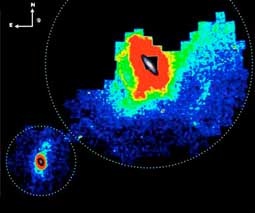
[further information and download]
Fig 1. PAndAS map of the neighborhood of the Andromeda galaxy
(Image credit: A. McConnachie/NRC; Triangulum disc by courtesy of T. A. Rector and M. Hanna)
Dr. Nicolas Martin of the Max Planck Institute for Astronomy, who is involved in the survey's data analysis: „Astronomers have found traces of such stellar streams before, but never been able to draw this kind of detailed map.“ The images show six distinct streams and arcs. Two of these were previously unknown, and none had previously been imaged in such detail. The data will serve as the basis for reconstructions of the last billions of years of Andromeda's cosmic history.
As Dr. Nicolas Martin says: „The stellar streams are the remains of dwarf galaxies that Andromeda has ingested. We caught a galactic cannibal in the act. Over the next billions of years, the stars in those streams will disperse, becoming an indistinguishable part of the galaxy's halo of stars.“
The study also sheds new light on the history of the Triangulum galaxy, a smaller galaxy that is a close companion to Andromeda. Dr Nicolas Martin again: „Previously, Triangulum was seen as no more than a companion. Now, we have compelling evidence that Triangulum had a close brush with Andromeda a few billion years ago.“ The evidence consists of a newly-found 'tail' of trailing stars in the Triangulum galaxy, produced by Andromeda's gravity during the close encounter.
Background information
The results reported here will be published in the September 3, 2009 issue of Nature. They are based on data obtained by the PAndAS project (short for „Pan-Andromeda Archaeological Survey“). This survey, which runs from 2008 to 2011, using the Canada-France-Hawaii Telescope (CFHT) on Mauna Kea in Hawaii, is set to create a detailed map of approximately 350 square degrees of the sky around the Andromeda galaxy (corresponding to an area more than 1,600 times the apparent size of the full moon).
At a distance of 2,500,000 light-years, the Andromeda galaxy (Messier catalogue number M31) is the spiral galaxy closest to our home galaxy, the Milky Way. Its central region is visible to the naked eye as a diffuse smudge on the sky. The main survey area, centered on Andromeda, covers an area around that galaxy nearly 1,000,000 light-years in diameter. Another part of the survey covers an area around the Triangulum galaxy (M33), a close companion of Andromeda, more than 300,000 light-years in diameter.
The PAndAS team includes members from Canadian, French, Australian, British, American and German institutions (including the Max Planck Institute for Astronomy in Heidelberg). The principal investigator of PAndAS is Dr Alan McConnachie of the NRC Herzberg Institute of Astrophysics in Victoria, Canada.
Contacts:
Dr. Nicolas Martin (Co-author)
Max Planck Institute for Astronomy
E-mail: martin@mpia.de
Phone: +49 6221 528-453
Dr. Markus Pössel (PR)
Max Planck Institute for Astronomy
E-mail: poessel@mpia.de
Phone: +49 6221 528-261
Figures
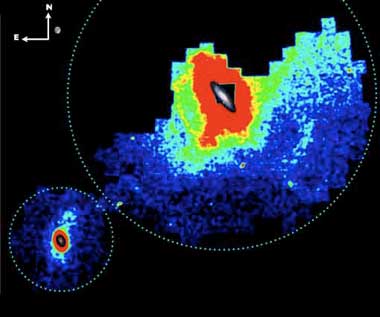
Download a hi-res version here (1920 x 1600 Pixel, 160 KB)
Fig 1. PAndAS map of the neighborhood of the Andromeda galaxy (top right), including the Triangulum galaxy (bottom left). The colors encode star density: Where the map is red, there are many stars; as the color goes to yellow, green, light and then dark blue, less and less stars are present. In the high-density (red) centers, optical images are inserted, which show the Andromeda and the Triangulum galaxy as they would appear in an ordinary telescope. The star distribution shows wisps, arcs, streams, and a few dwarf galaxies. A number of these structures are new discoveries, and none had previously been imaged in such detail. The diameters of the dotted circles are approx. 900,000 light-years and ap-prox. 300,000 light-years, respectively, marking the survey area. An image of the full moon (top left) is included to give a sense of scale.
(Image credit: CFHT / PAndAS)
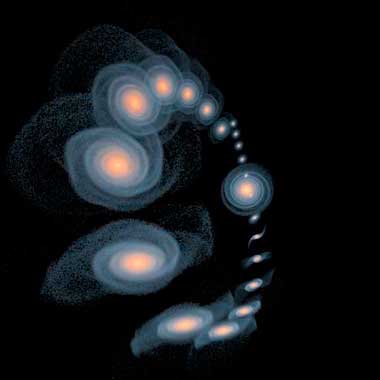
Download a hi-res version here (4096 x 4096 Pixel, 600 KB)
Fig 2. A stroboscopic projection of a high-resolution numerical simulation of a possible orbit of the Triangulum galaxy around Andromeda. Andromeda is the round disk center right. The shape of the Triangulum galaxy, here shown in several different positions on its orbit, changes under the influence of the gra-vity of the Andromeda galaxy. The simulations suggest that, eventually, the Triangulum galaxy will be devoured by Andromeda.
(Image credit: PAndAS)
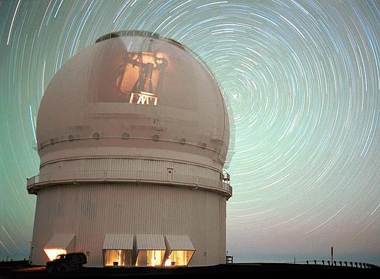
Fig. 3. The Canada-France-Hawaii Telecope on top of Mauna Kea, Hawaii. The picture data of the PAndAS project were gathered with this telescope.
(Image credit: Jean-Charles Cuillandre, CFHT)
Journalists can get a high-resolution version of this picture. Please ask: Axel M. Quetz, MPIA.
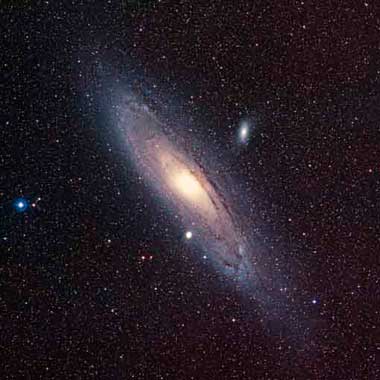
Download a hi-res version here (1920 x 1920 Pixel, 1.5 MB)
Fig 4. Additional image (not produced in connection with the new research described in this press release): The Andromeda as it appears through a large telescope.
Image taken by Kurt Birkle (Max Planck Institute for Astronomy) with the Schmidt Telescope at Calar Alto Observatory.
(Image credit: Kurt Birkle, MPI for Astronomy)